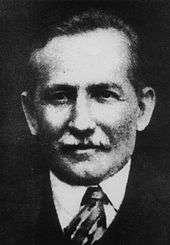Naum Faiq
| Naum Elias Yaqub Palakh ܢܥܘܡ ܐܠܝܐܣ ܝܥܩܘܒ ܐܝܠܝܐܣ | |
|---|---|
 | |
| Born |
February , 1867 Diyâr-ı Bekr, Ottoman Empire |
| Died |
February 5, 1930 (aged 63) New Jersey, United States |
| Occupation | Teacher, Journalist, Thinker |
| Movement | Assyrian nationalism |
Naum Elias Yaqub Palakh (February 1868 – February 5, 1930), better known as Naum Faiq (Syriac: ܢܥܘܡ ܦܐܝܩ, Naˁum Fayëq) was one of the founding fathers of modern Assyrian nationalism during the early 20th century.[1][2] He was a teacher and writer throughout his life. A Syriac Orthodox[3] Christian, he emphasized the importance of unity among Assyrians and encouraged his community to depart from "tribal mentality."[4]
Early life
He was born in Diyâr-ı Bekr (present day Diyarbakir) in the Ottoman Empire and began his education there at the age of seven. After primary school, he attended the local high school that had been established by local "Brotherhood of Ancient Syrians". He spent 8 years at the school, where education was jointly in classical Syriac, Ottoman Turkish and Arabic. Naum also went on to learn several other languages, including Persian and basic French. After his parents died, he first lived with his older brother Thomas and then started teaching in a village near Diyarbakır in 1888. He also taught in Urfa, Adıyaman and Homs before returning to Diyarbakır.
Literary works
Naum wrote numerous books concerning the Syriac language and people. After the 1908 Young Turk Revolution and the proclamation of the second Ottoman constitution, restrictions on freedom of speech were lifted. In 1910, Naum began publishing a newspaper for the Orthodox, Catholic and Protestant Syriac communities, entitled Kawkab Madnho ("Star of the East"). While written entirely in the Syriac alphabet, Star of the East was actually tri-lingual with articles in Ottoman Turkish, classical Syriac and Arabic. This newspaper, along with that of Ashur Yousif, signaled the emergence of Assyrian nationalism in the Syriac Christian communities of the Ottoman Empire.
After the Ottoman Empire and Italy began to fight over the province of Libya in 1911, Naum like other Christians in the region felt a backlash from the Muslim community and in 1912, he fled to United States, where he began to write for the newspaper Intibah ܐܢܬܒܗ (Cirutho ܥܝܪܘܬܐ, in English: Awakening), published by Gabriel Boyaji from 1909-1915. He went on to establish various Assyrian newspapers including Beth-Nahrin in 1916 and became the head of the editorialship of Huyodo, a magazine that is still published today under the same name in by the Assyrian Federation in Sweden.
Death
The death of his wife in 1927 affected Naum very much. He died in New Jersey in 1930 due to lung disease. "Naum Faiq" day is celebrated yearly on February 5.[5] Ceremonies are usually held in Syria, United States, and in various European nations.
Poems
Awake, son of Assyria
His most famous poem is titled "Awake, son of Assyria, awake!"[6][7] (ܐܬܬܥܝܪ ܒܪ ܐܬܘܪ ܐܬܬܥܝܪ).
| “ |
|
” |
| — Naum Faiq[8] | ||
Homeland
| “ |
|
” |
| — Naum Faiq[8] | ||
See also
References
- ↑ "A Brief Study in the Palak Nationalism", by Dr. David Barsoum Perley LL.B.
- ↑ In memory of Malfouno Naoum Fayiq, the master of the national unity, by Aprim Shapera.
- ↑ Yonan, Gabrielle (1985), Journalismus bei den Assyrern
- ↑ "Neo-Assyrianism & the End of the Confounded Identity". Zinda. 2006-07-06. Archived from the original on 2007-12-01.
The fact remains that throughout the last seven years and the last 150 years for that matter the name Assyrian has always been attached to our political ambitions in the Middle East. Any time, any one of us from any of our church and tribal groups targets a political goal we present our case as Assyrians, Chaldean-Assyrians, or Syriac-Assyrians – making a connection to our “Assyrian” heritage. This is because our politics have always been Assyrian. Men like Naum Faiq and David Perley emerging from a “Syriac” or “Jacobite” background understood this as well as our Chaldean heroes, General Agha Petros d-Baz and the late Chaldean Patriarch Mar Raphael BiDawid.
- ↑
- ↑ http://www.bethnahrin.de/Bilder/060205Naum_Faik/assyrisch/5.JPG
- ↑ http://www.cavemanart.com/osroene/turkoassyrian.htm
- 1 2 Naum Faiq (2005). "Seyfo Commemoration and Demonstration in Brussels". Zinda Magazine. Archived from the original on 2013-01-11.
- Chuqqî, Murâd Fu'âd (1936). Na'ûm Fâ'iq. Dhikrâ wa-takhlîd al-adîb al-suryânî al-kabîr.